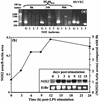1,25-Dihydroxyvitamin D3 induces nitric oxide synthase and suppresses growth of Mycobacterium tuberculosis in a human macrophage-like cell line
- PMID: 9784538
- PMCID: PMC108664
- DOI: 10.1128/IAI.66.11.5314-5321.1998
1,25-Dihydroxyvitamin D3 induces nitric oxide synthase and suppresses growth of Mycobacterium tuberculosis in a human macrophage-like cell line
Abstract
Inducible synthesis of nitric oxide (NO) by macrophages is an important mechanism of the host defense against intracellular infection in mice, but the evidence for significant levels of inducible NO production by human macrophages is controversial. Here we report that the human promyelocytic cell line HL-60, when differentiated to a macrophage-like phenotype, acquires the ability to produce substantial amounts of NO on stimulation with LPS or 1, 25-dihydroxyvitamin D3 (1,25-D3) in the absence of activating factors such as gamma interferon. Expression of the inducible nitric oxide synthase (NOS2) was confirmed by sequencing of the reverse transcription-PCR product from stimulated HL-60 cells. Kinetic studies after lipopolysaccharide stimulation show that NOS2 mRNA levels rise within 3 to 6 h, that conversion of [14C]arginine to [14C]citrulline is maximal at 5 to 6 days, and that levels of reactive nitrogen intermediates stabilize at around 20 microM at 7 to 8 days. We find that 1,25-D3 acts to suppress the growth of Mycobacterium tuberculosis in these cells and that this effect is inhibited by NG-monomethyl-L-arginine, suggesting that vitamin D-induced NO production may play a role in the host defense against human tuberculosis.
Figures

 ), LPS (100 ng/ml) (□), PMA (10 ng/ml) (
), LPS (100 ng/ml) (□), PMA (10 ng/ml) ( ), or LPS (100 ng/ml) plus PMA (10 ng/ml) (
), or LPS (100 ng/ml) plus PMA (10 ng/ml) ( ). (c) Inhibitory effect of
). (c) Inhibitory effect of 



References
-
- Bellamy, R., A. V. S. Hill, et al. Unpublished data.
-
- Brackman D, Lund Johansen F, Aarskog D. Expression of leukocyte differentiation antigens during the differentiation of HL-60 cells induced by 1,25-dihydroxyvitamin D3: comparison with the maturation of normal monocytic and granulocytic bone marrow cells. J Leukoc Biol. 1995;58:547–555. - PubMed
-
- Brincourt J. Le calcifél a-t-il une action liquéfiante sur le caséum. Le poumon et la coeur. 1967;23:841–851. - PubMed
Publication types
MeSH terms
Substances
LinkOut - more resources
Full Text Sources
Medical

